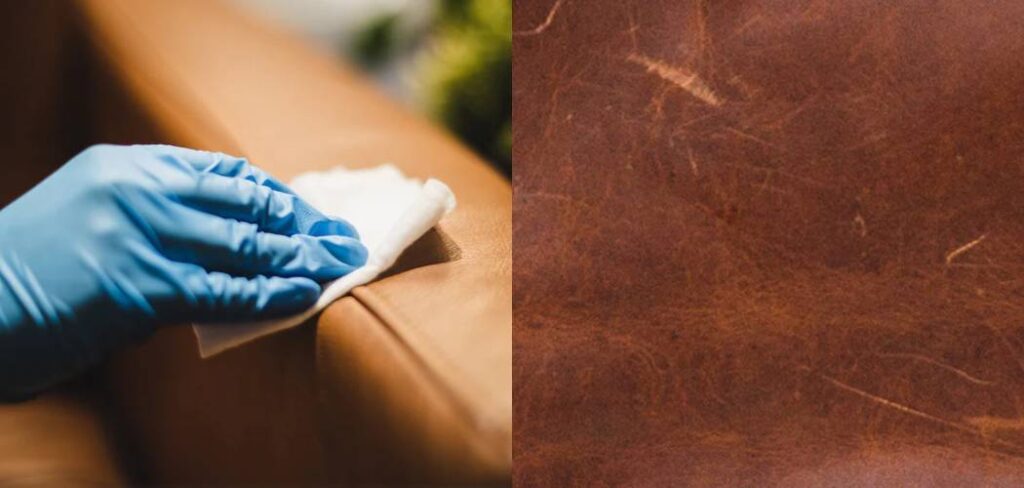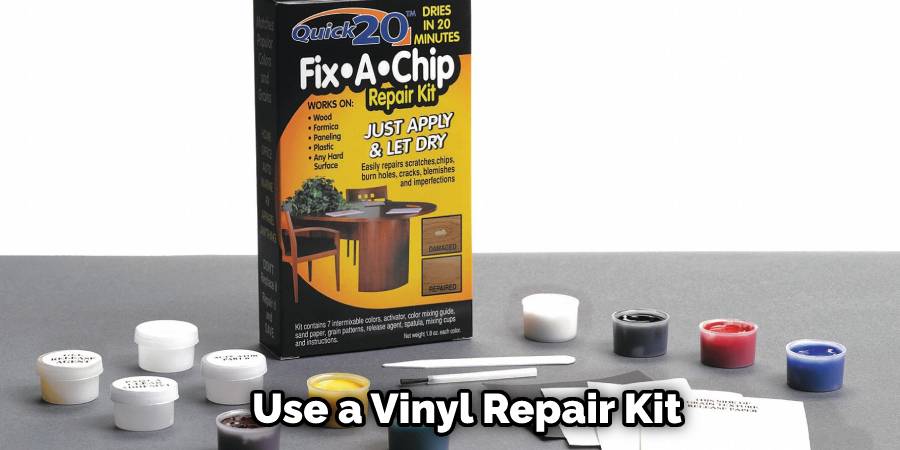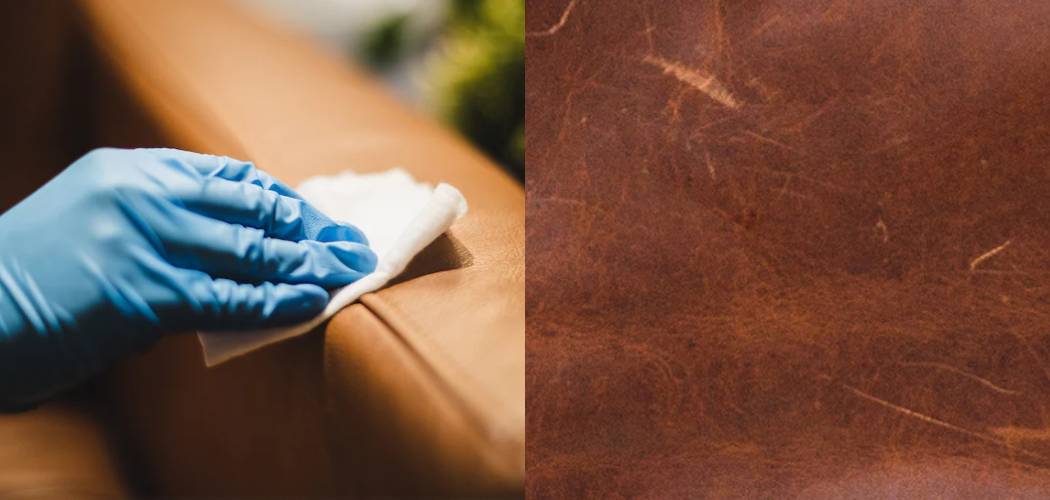Do you have a leather couch with scratches marking its beautiful surface? Don’t worry. There are a few easy methods to remove those unsightly marks.
Leather couches are a popular choice for furniture, but they can be prone to scratches. If your leather couch has some unsightly scratches, don’t worry – there are ways to fix them! In this blog post, we’ll show you how to remove scratches from leather couch using simple household materials. Keep reading for tips on how to restore your leather couch’s appearance.

Removing scratches from leather furniture can seem daunting, but with the right products and techniques, it can be a breeze. In this blog post, we’ll walk you through the steps necessary to remove any scratches from your leather couch. So grab your supplies and get to work!
How Can Leather Couch Get Scratches?
Before we dive into the removal process, let’s take a moment to understand why leather couches can get scratched in the first place.
Leather is durable, but it can still be susceptible to damage from sharp objects or rough treatment. Such as pets, children, or even accidental scratches while moving furniture. It’s important to take steps to prevent scratching, such as using coasters and trimming pet nails regularly.
But if your leather couch has some scratches, don’t despair. There are ways to remove them and restore the appearance of your leather furniture.
10 Easy Steps on How to Remove Scratches From Leather Couch:
Step 1: Removing Surface Scratches
For surface-level scratches on leather couches, try rubbing a small amount of olive oil or vinegar into the scratch using a soft cloth. Let it sit for about 10 minutes before wiping off any excess moisture with another clean cloth. This technique can help mask smaller surface scratches on your leather couch.
If this doesn’t work or for deeper scratches, proceed to the next step.
Step 2: Get a Leather Repair Kit
There are various leather repair kits available on the market. These contain colors and finishes that match different shades of leather and tools for filling in scratches and blending them with the surrounding area.

Follow the instructions included in your kit to apply color and finish to the scratched area on your couch. Let it dry before touching or sitting on the repaired area.
Step 3: Use Shoe Polish (for Dark Colored Leather Couches)
For darker colored leather couches, try using a small amount of matching shade shoe polish. Apply it onto the scratch with a soft cloth and rub it into the leather until it blends with the surrounding area. Then, buff it with a clean cloth to remove any excess shoe polish.
Step 4: Use Leather Conditioner or Cream
After removing the scratches is important to restore moisture and protect the leather. Use a leather conditioner or cream and apply it evenly onto the couch using a soft cloth.
Let it sit for a few minutes before wiping off any excess product with a clean cloth. Regularly conditioning your leather couch will help prevent future scratching and maintain its appearance.
Step 5: Use a Leather Dye or Tint
In cases of deep or severe scratches, try using leather dye or tint to restore the color to the scratched area on your couch. Apply with a small brush and blend it into the surrounding leather until the scratch is no longer visible. Let it dry before touching or sitting on the repaired area.
Step 6: Use a Vinyl Repair Kit (for faux leather couches)
For faux leather couches, try using a vinyl repair kit. These kits contain colors and finishes that match different shades of faux leather and tools for filling in scratches and blending them with the surrounding area.

Follow the instructions included in your kit to apply color and finish to the scratched area on your couch. Let it dry before touching or sitting on the repaired area.
Step 7: Use Nail Polish (for faux leather couches)
If your leather couch is actually faux leather, you can try using nail polish to cover up the scratches. Simply apply a color that matches the couch and let it dry before touching it. Keep in mind that this method may not provide a perfect fit and may need to be reapplied periodically.
Step 8: Use Hair Spray
If the previous steps have not completely removed the scratch, try using hair spray on a cloth and gently rubbing it into the scratch.
The alcohol in the hair spray can often remove stubborn scratches from leather surfaces. Make sure to test it on a small, inconspicuous area first before applying it to the entire scratched surface.
Once you have applied the hair spray, allow it to dry and then buff it with a clean cloth to blend it into the rest of the couch’s surface.
Step 9: Apply Leather Protection
To help prevent future scratches, consider applying a leather protection product to your couch. This will create a barrier against scuffs and wear and tear, making it easier to remove any future scratches.

Always remember to test any products on a small, inconspicuous area before using them on larger surfaces to ensure they do not cause damage or discoloration. And be sure to follow the manufacturer’s instructions for proper application and maintenance.
Step 10: Contact a Leather Repair Professional
If all else fails, try contacting a leather repair professional. They have specialized tools and techniques to restore even the most severe scratches on your leather couch.
Following these steps can help minimize any damage and keep your leather couch looking its best. Also, be gentle and careful when rubbing or buffing in any products to avoid causing additional scratches.
You Can Check It Out to Fix Sofa Leather
5 Additional Tips and Tricks
- Use a cotton swab or microfiber cloth soaked in rubbing alcohol to rub the scratch gently.
- Try mixing vinegar and olive oil to create a homemade leather conditioner and apply it on the scratch.
- Use shoe polish that matches the color of your couch to fill in the scratch and blend it with the surrounding area.
- Use a pencil eraser to rub against the scratch, as the rubber can help diminish its appearance.
- Consider purchasing a leather repair kit specifically designed for furniture, which often includes various tools and materials for repairing scratches and other damage.
These tips can help you effectively remove scratches from your leather couch and make it look as good as new.
5 Preventive Measures to Avoid Future Scratches
- Keep sharp objects away from the couch, such as knives or keys.
- Place protective covers on furniture when using it for crafting or other activities that may cause damage.
- Train pets to stay off of the furniture and trim their nails regularly to prevent scratching.
- Promptly clean up any spills or messes to avoid staining and damaging the leather.
- Regularly condition and polish the leather to keep it in good shape and prevent cracking or tearing. By taking these preventive measures, you can help ensure your leather couch stays scratch-free for longer.
I hope these tips and tricks help you remove scratches from your leather couch and prevent future damage. Happy repairing!

Does Olive Oil Remove Scratches of Leather?
While some people swear by using olive oil to remove scratches from leather, it is not recommended as a long-term solution. The oil may temporarily cover up the scratch, but it can also attract dirt and cause discoloration over time.
It’s best to stick with products specifically designed for leather repair or seek professional assistance. Alternatively, you can try using a small amount of olive oil mixed with vinegar as a homemade leather conditioner.
Can Scratches be Buffed Out of Leather?
Depending on the severity of the scratch, it may be possible to buff it out using a soft cloth or sponge. Gently rub abrasive materials, such as toothpaste or baking soda, onto the scratch in circular motions until it diminishes in appearance.
However, this method may not be effective for deep scratches that have affected the leather’s texture. Try using a leather repair kit or contacting a professional for assistance in these cases.
Frequently Asked Questions
Can You Get Scratches Out of Leather Couch?
There are a few ways to get scratches out of leather. One way is to use a cream polish that is specifically designed for leather. This will help to restore the shine and make the scratches less visible. You can also use a household cleaner like Dawn or 409 to clean the area and remove any dirt or debris. Finally, you can use a furniture polish that is specifically designed for leather. This will help to make the surface look new again and reduce the chances of future scratches.
Does Olive Oil Remove Scratches Leather?
Olive oil is a natural oil that is often used to remove scratches from leather. It works by absorbing into the scratches and breaking them down, which then causes the Leather to heal over the scratches. Olive oil can be used on a variety of different types of leather, and it is generally safe to use on leather that has not been treated with any other chemicals or treatments.
Which Oil is Best for Leather?
There is no one oil that is best for leather, as the condition and care of leather depends on a variety of factors, including the type of leather, the climate, and the user’s specific preferences. As a general rule, oils that are high in linoleum or polyurethane will be better suited for use on leather than oils that are heavier or oil-based. Some oils that are commonly used on leather include jojoba, avocado, grapeseed, and olive oil. It is important to test an oil on a small area of your leather product before applying it to the entire piece to ensure compatibility and optimal results.
Is Coconut Oil Good for Leather?
There is some debate over whether or not coconut oil is good for leather, as some people believe that it can damage the material. However, most experts suggest that coconut oil can be used to treat and preserve leather, as it has a number of properties that can help improve its condition. Coconut oil is antibacterial and anti-fungal, which helps to prevent the growth of mold and fungus. It also has a high smoke point, meaning that it can withstand high temperatures and burning oils, which can help to prevent damage to the leather. In addition, coconut oil is moisturizing and conditioning, which helps to make the leather feel softer and smoother. Finally, coconut oil is effective at repelling water, which helps to keep the leather dry and protected from moisture damage.
Conclusion
Scratches on leather furniture can ruin the look of an otherwise perfect piece. However, there’s no need to worry – there are a few easy ways to remove scratches from leather couches! By following these simple tips, your couch will look good as new in no time.
Last but not least, if you have any big scratches that go through the leather’s topcoat, you can use a Leather recoloring balm. First, find a color that matches your leather couch as closely as possible.
Then apply the recoloring balm with a rag following the product directions. The goal is to make the scratch less visible by filling it in with color. These are just a few ways to fix those pesky leather couch scratches!
You can remove scratches from your leather couch with a few common household items. By following the steps outlined in this article on how to remove scratches from leather couch, you can make your couch look like new again.

